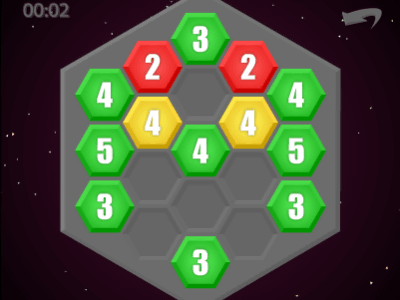Exploring the ground and collecting materials to build the city I tried playing the board game "Above and Below" thoroughly kneaded

Due to the advent of the cloud funding site, it is a type of analog gameExpanding the popularity of board games all over the worldWhile doing it is one of the cloud funding sitesLooking for investment with KickstarterI was playing the board game "Above and Below」Achieved a goal investment amount nicely and it was commercialized and sent to GIGAZINE editorial department so I tried playing immediately.
Above and Below | Red Raven Games
http://www.redravengames.com/aboveandbelow/
This is Above and Below.

Above and Below is for 2-3 players and over 13 years old. One play is about 90 minutes.

A lot of cards and boards were in the box.

This is what we call a token.
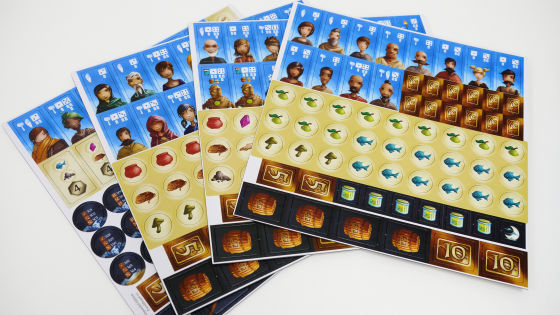
I will remove tokens one by one from the board.

From the top 18 villagers, 12 starting villagers, 6 special villagers. Three kinds are similar in appearance, but the house is printed on the back of the second row is the starting villager, the special villager has the cave in the third row drawn.
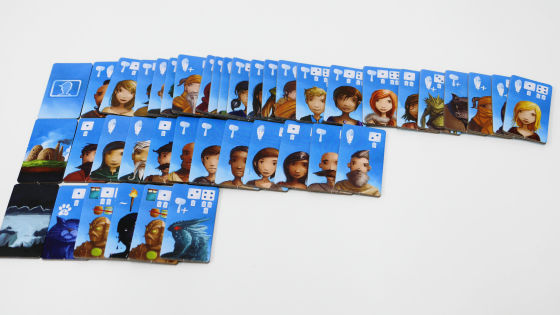
Pear, fish, mushroom, vase, rope, mineral, paper, emerald The item tokens are 81 in total.
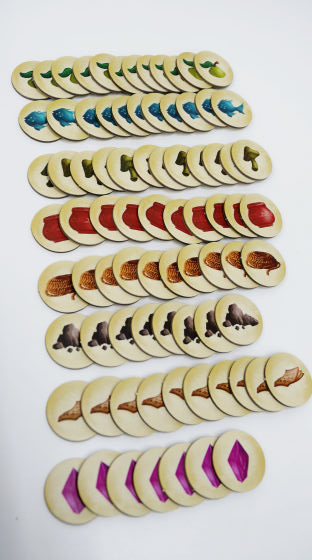
Coins to be the currency of the game are 1. 5 · 10.
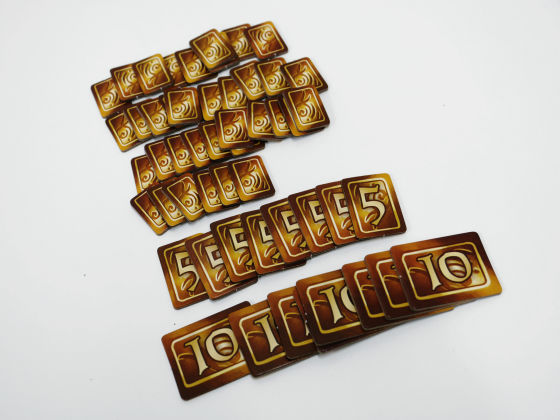
Potion with green liquid in the bottle Cider token with a token / tal is drawn · Round marker printed the moon.
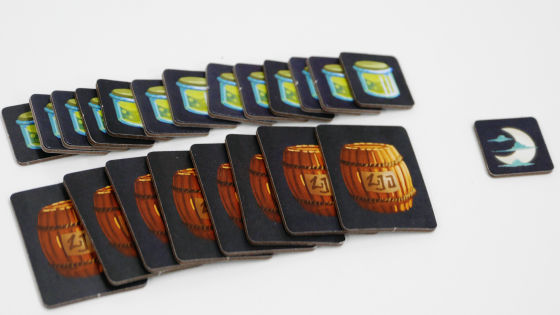
The card is a house card · a key house card with a key drawn on the upper left · a star house card with a star · a house start card with a bed printed · an out post card · a house built by a house in a cave Total of seven cave cards with only one eye and first player card with only one eye.
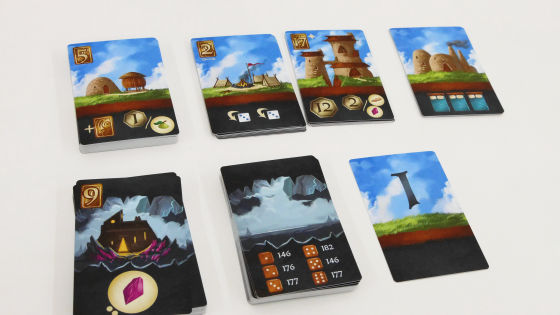
The four on the left are the player board and the one on the right is the reputation board (a board that the player does not use directly).

This is an encounter book (a book with a story written).
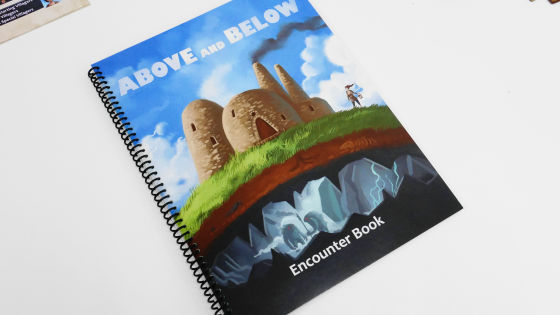
English sentences are crowded inside.
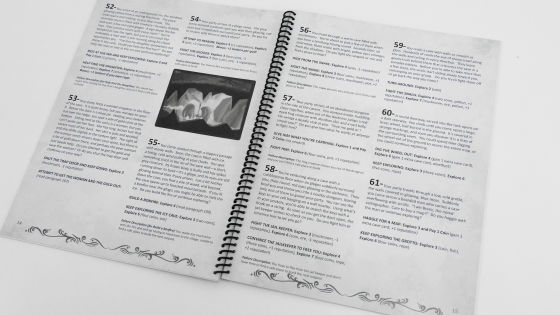
When you look closely it is numbered and the story of the event occurring inside the cave is written.
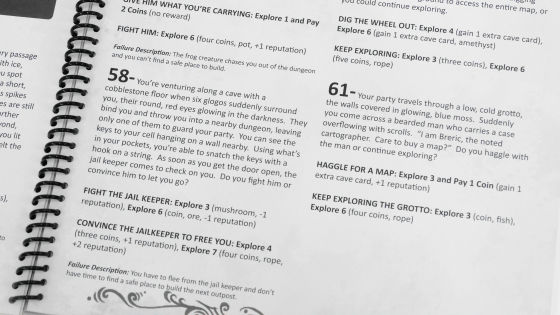
There are seven dice in all, and the colorful cube on the right is like a piece of player placed on the reputation board.
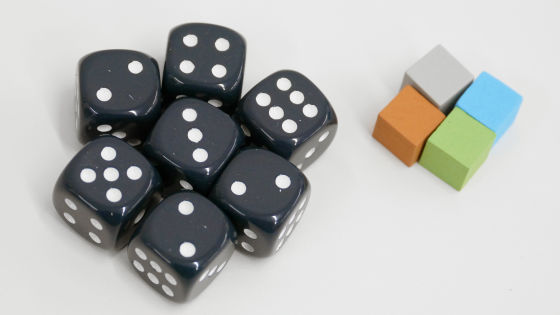
Something like a cute wooden piece ......
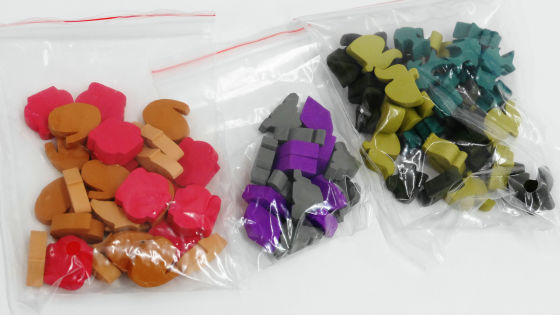
Since it is said that the token of this board is to be used with the rule exclusive for the extended model, I will put it in the box without using this time.
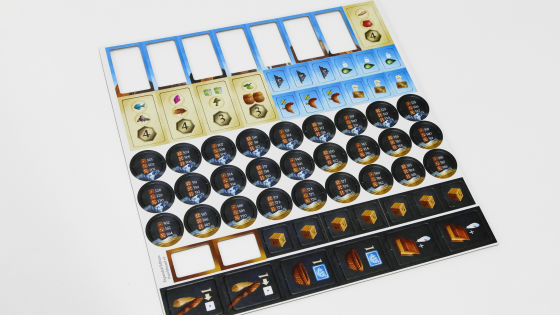
I prepared the game where I confirmed the contents. Since we will play with two people this time, we will distribute player board × 1 and starting villager × 3 to each. Leaving the starting villagers dealt in the left space of the board.
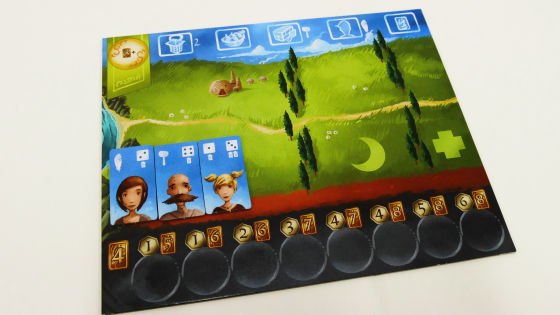
The starting villagers who distribute are one with only the dice, one with the hammer printed on the upper left, one with the feathers drawn on the upper left.
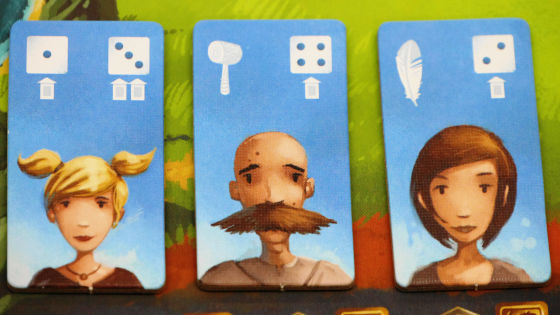
It is seven coins in total to distribute to players, which will become money at the start.
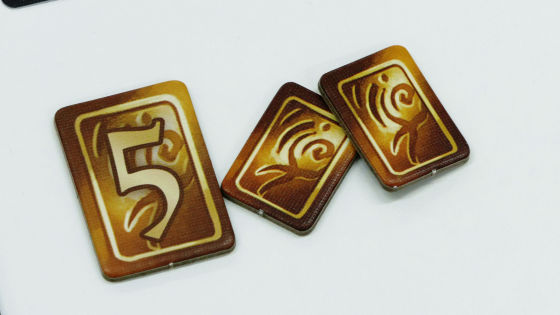
Placing the starting house card on the right side of the player board, the player board preparation is completed.
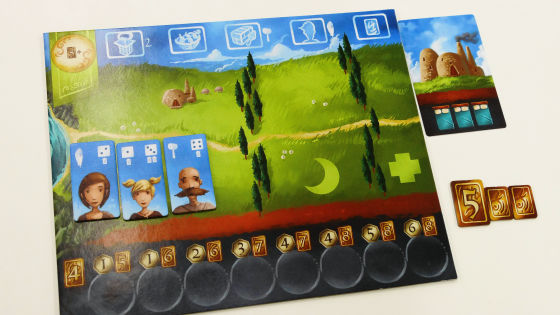
Next, arrange six Star House cards and four key house cards on the table.
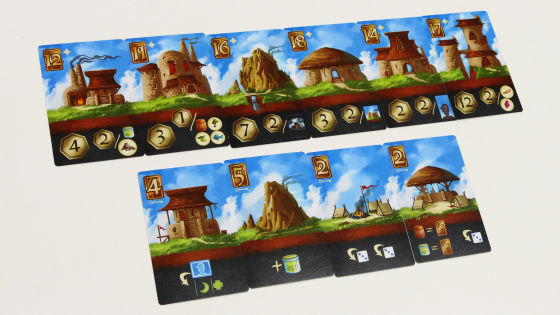
Place the reputation board on the table, arrange five villager cards at the top of the board and the rest on the right side of the board.

The round marker is located at the entrance of the cave in the middle part of the reputation board.
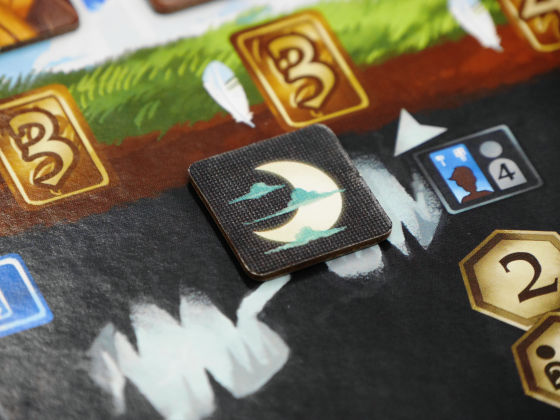
There are seven caves, which means that the game has seven rounds in all. After the first round, you can move the round marker one down.
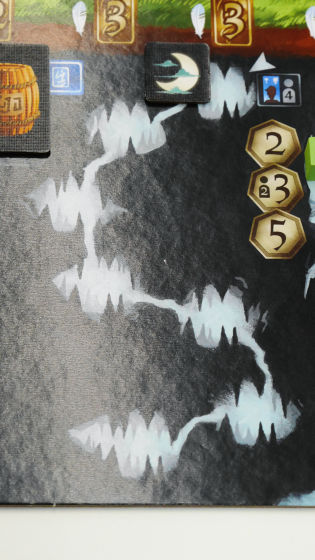
Place the cider token on the left side of the round marker.
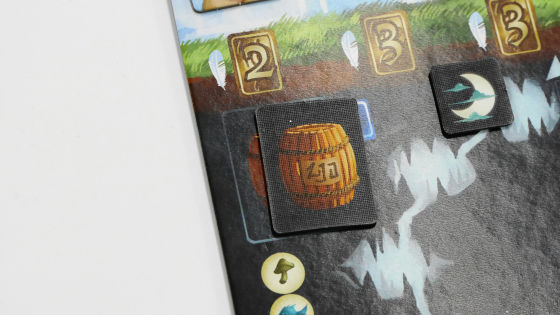
Arrange the cave card face up on the bottom left of the reputation board.

Item Token · Potion Token · Coin is safe if it is close to the reputation board.
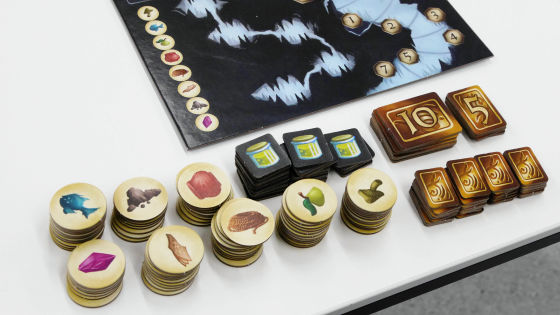
In addition, shuffle the house cards and outpost cards and place them for the back, arranging four cards from the top and arrange them on the right side of the mountain.
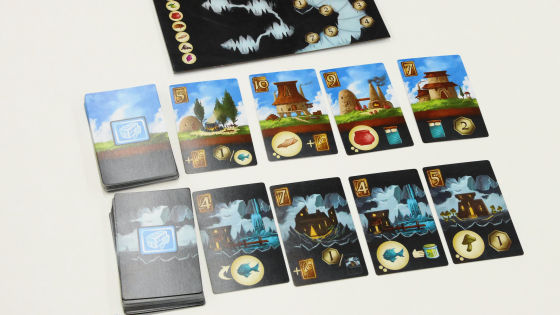
From the four color cube, pick the same color as the upper left corner of the player board ......
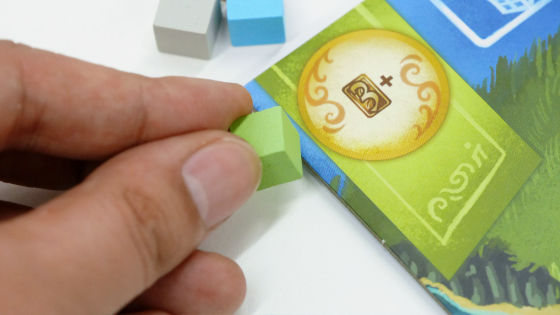
Place it on the torch of the reputation board. This time player 1 is green and player 2 is blue.
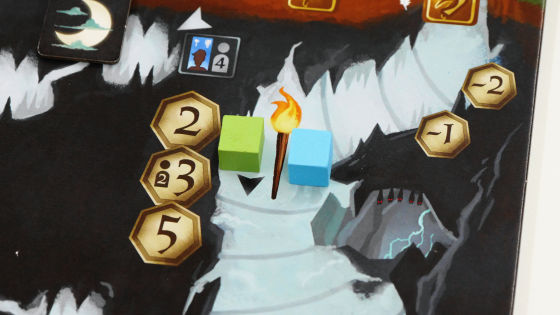
Finally it is ready if you put the first player card on the left side of the board of the player who plays first.
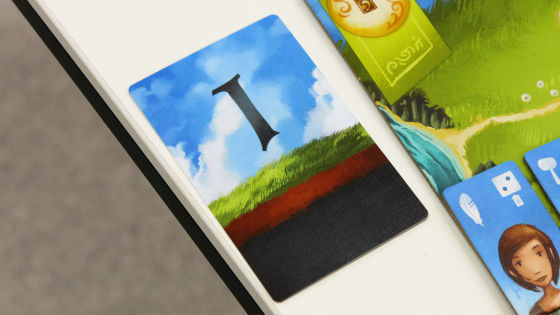
In the case of two players, setting it all up is like this. It is related to the player that is arranged on both sides, and in the middle we arranged three kinds of house cards and outpost cards so as to pinch the reputation board. It is not necessary not to be in this way, anything is ok if it is easy to understand.

As soon as I started playing the game from Player 1. Basically, you can do five actions "exploration" "construction" "harvest" "employment" "labor" in one round, but you need to use one or more villagers per action. The action will be one player per round, but as many villagers as you permit, go as many times as you want. Since this time it is two playing, we will take action one time at a time and if the action becomes impossible either, the round ends. Above and Below's basic rule is to repeat this seven times and finally compete for the total points. Since the action has quite a detailed setting, I will write the details while playing.
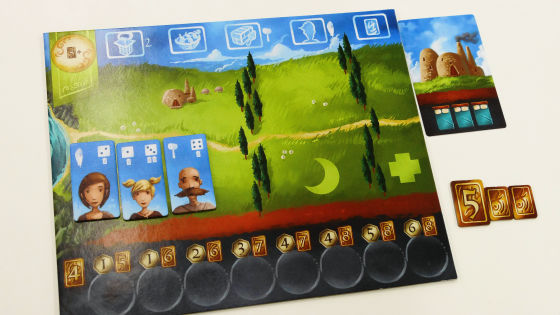
Since the funds are small at the beginning of the game, I will try "explore" for the time being. To do an exploration draw a cave card, set it in the lower left of the player board.

More than 2 people are needed for exploration. The point at which the dice drawn on the top of the villager grasps the key in exploration.
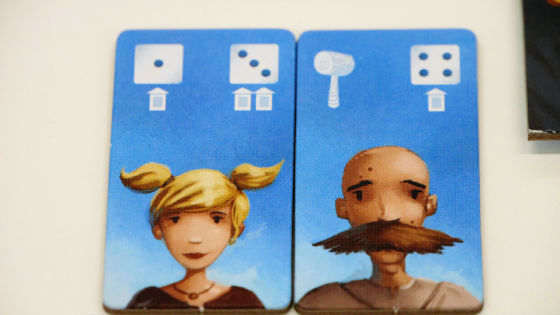
I pulled the dice once I pulled a cave card and 3 got out this time. "177" is written on the right side of the part 3 under the cave card, which means that you read 177 of the encounter book.
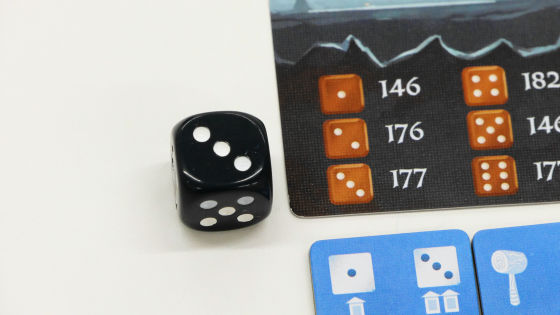
Have the player 2 read the sentences written on the encounter book number 177. To summarize number 177, "A botanist lost his cane and got lost in the cave, you may be able to make a new cane with craps falling in the cave." There are options below that "help her" and "take away items from her". "Help 3" or "Explore 7" is required for "to help her", "4" for the number called "Explore", "to take items from her" and "Explore 7" for each, Player 1 is not allowed to hear the reward. In other words, you need to choose one from two options without listening to rewards.
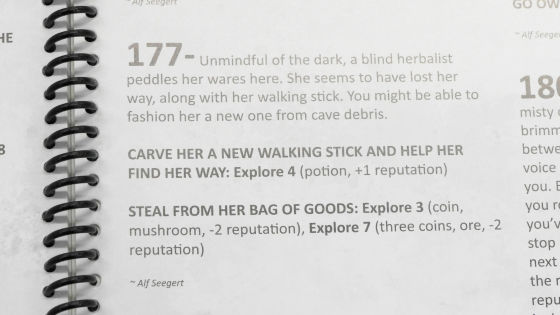
After choosing one from the choices, I roll the number of dice as many as the villagers. You can get a lantern corresponding to the number of dice written on the villagers and you will get reward if the total lantern is greater than the value of "Explore" set in the choice. In this case, Explore chose "take away items from her" from 3 and 7, and the eyes of dice were 3 and 1. The villagers on the left have 1 or more dice, 1 lantern, 3 or more lanterns, and the villagers on the right have dice and more than 4 lanterns. In other words, we could only get two lanterns this time, and we could not surpass Explore 3.

However, if the number of lanterns is insufficient, you can get one lantern by moving one villager to the area where the player board cross is drawn. We used this to make the number of lanterns a total of 3, successfully getting a reward this time.
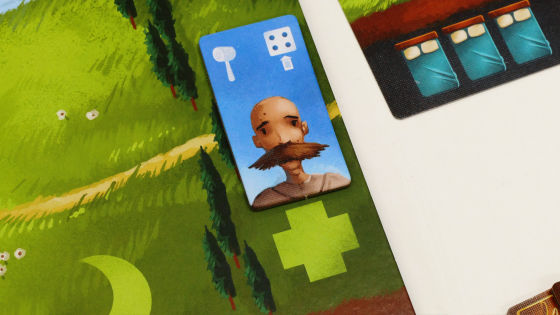
The reward was mushroom × 1 and coin × 1.

However, because there was "evaluation minus 2" in the remuneration, you have to lower your reputation board's own two pieces. The value of "evaluation" leads to points that can be earned at the end of the game, so it is better not to lower it as much as possible.

Move the crying green piece to "-2" place.

After expedition the cave cards are placed on the right side of the player board. You can not build an outpost card unless you own a cave card. As for the construction of the out-post card, since it comes out later, the explanation here is omitted.
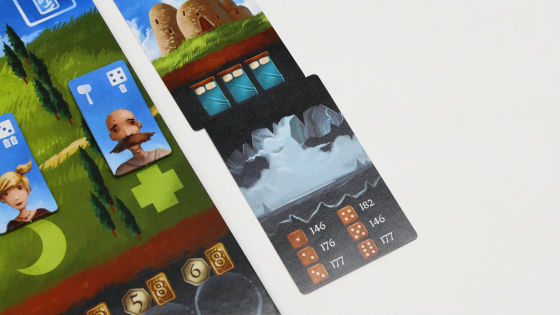
If you can not get the reward, you can return the cave card to the bottom of the mountain.

The other villagers used in "exploration" will move to the area where the month of the player board is drawn. The moon area and cross area become zones of rest and villagers here can not take action unless they return to the area on the far left. Also, since only one area can be returned, the villagers who have the beards on the far right can not take action unless they return two areas. Player 1's action is now over.
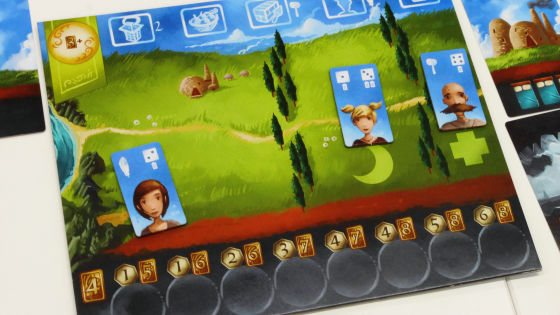
Next is player 2's turn.
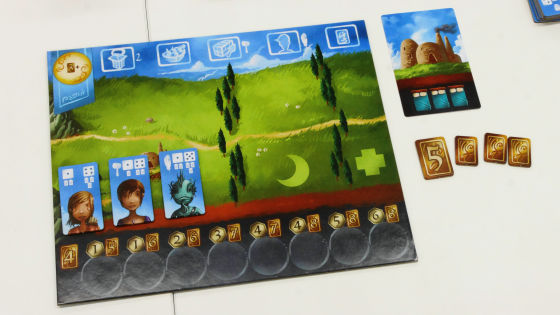
Player 2 will try "building" using the villagers whose hammer in the middle is drawn.
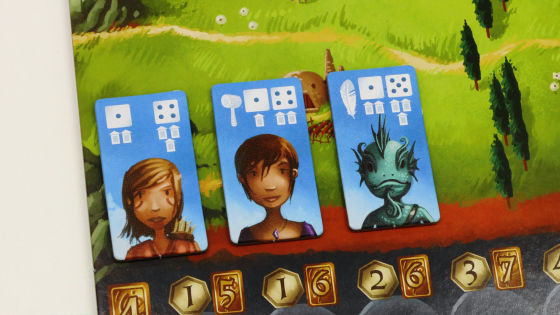
Built built by the Star House card and the key house card on the reputation board ......
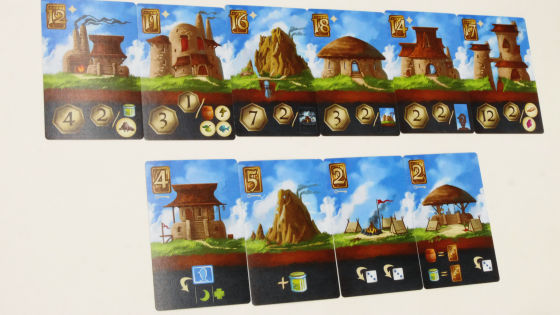
One of house cards and outpost cards under the reputation board.

The number written on the upper left of the card is the cost of building, the star house card is quite expensive.
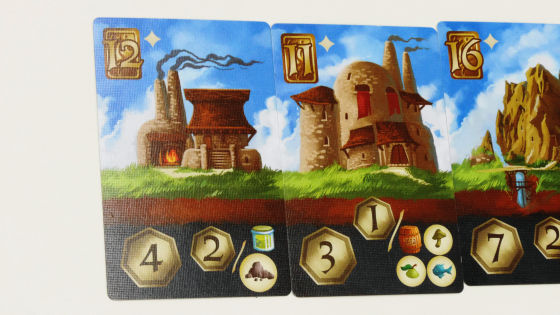
Conversely the cost of the key post card is low.
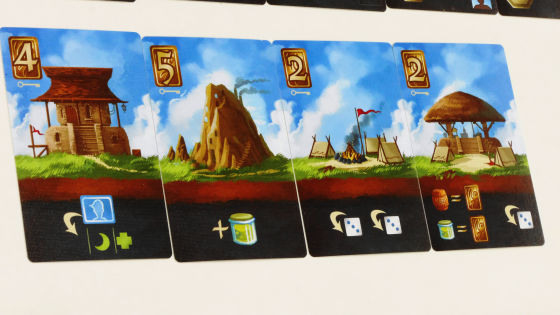
It is a symbol written on the bottom of the card that affects construction costs. This means skills that can be used when building, the following symbols will make it possible to use villagers that can be added at the action of "employment" immediately. At the time of employment action, villagers must be placed once in the "rest zone", but if you have an image card you can skip the rest zone and use it immediately.
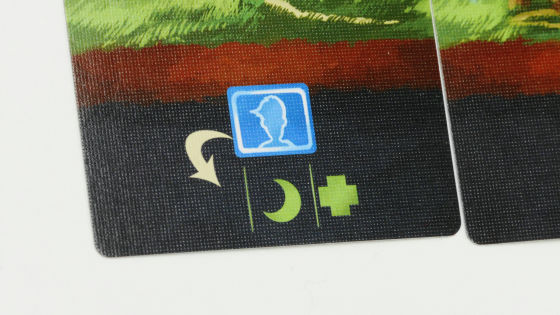
This is a symbol that gets potions when built.
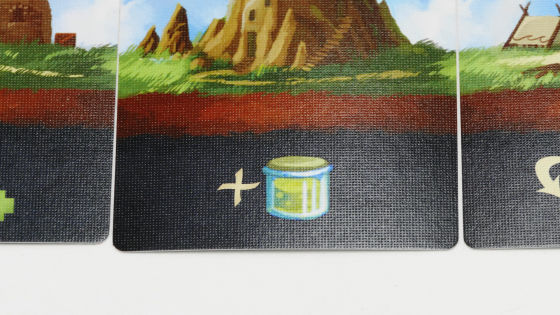
Starhouse cards are expensive, and there are skills that can change cooks for cider token / portion tokens, and multiple skills that roll the dice again.
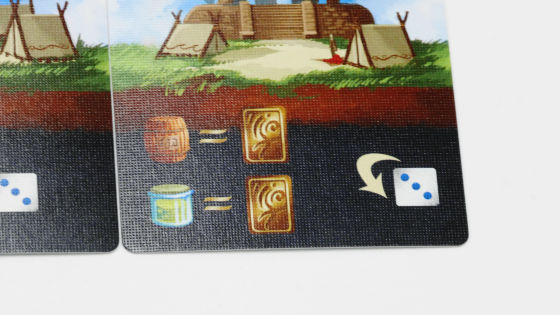
Move the villager whose hammer was drawn to the rest zone ...
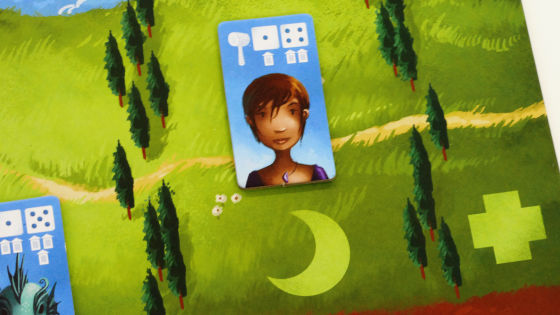
The key house card which is built by consuming two coins is arranged on the right side of the house start card. The key house card I got had the skill "I can roll the dice twice".
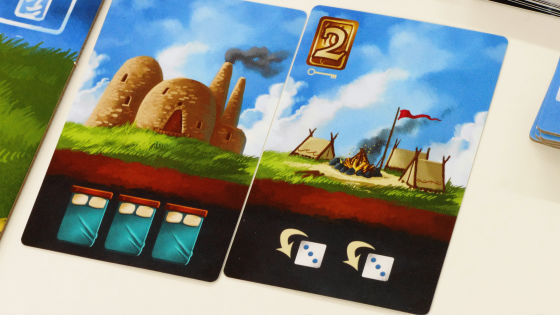
When the action of player 2 is over, it is number of player 1 this time. Even so, there is only one villager who can take action.
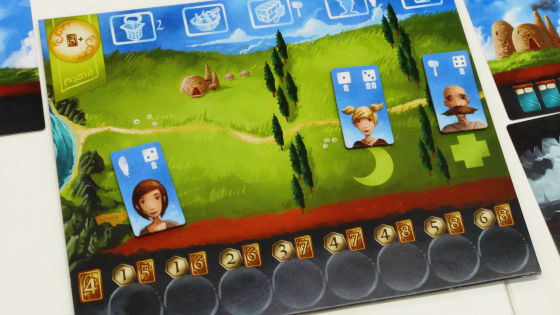
The villagers who can do the action have the wings mark written, which means that they can "employ".
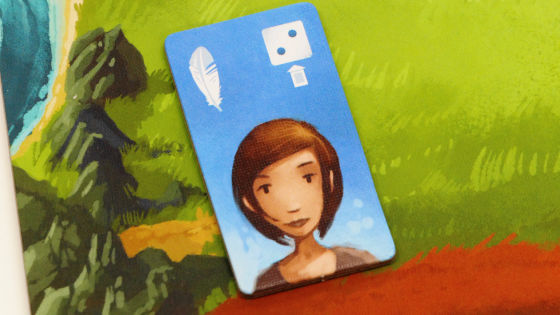
The newly hired villagers can choose from 5 rows on the reputation board. However, it is written "2.3.3.4.5" under the villagers and it is necessary to use coins by the number.
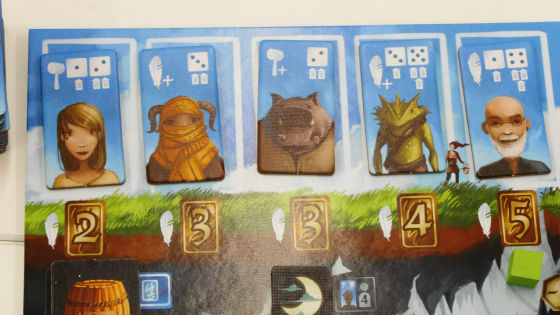
In this time there are few coins, so we decided to hire the left female villager who can hire with two.
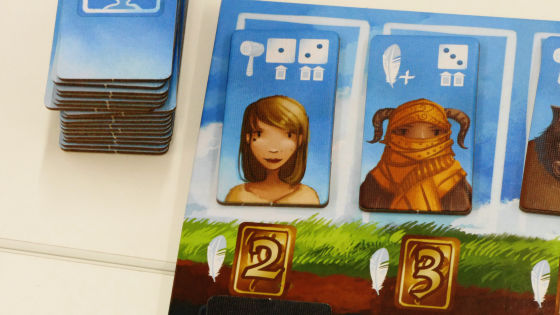
The newly hired villagers will be able to move to the rest zone and take immediate actions unless you get a special skill house card. Player 1 has no villagers who can take action, so the first round is over.

Player 2 continues the first round because there are two villagers who can take action.
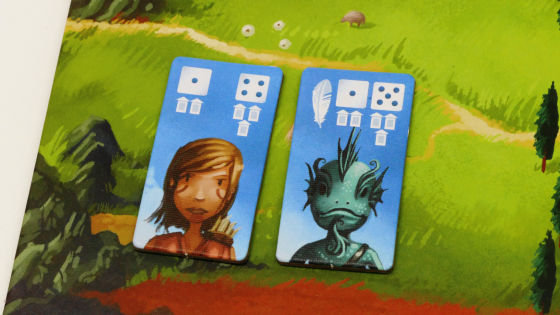
We will explore with two villagers.
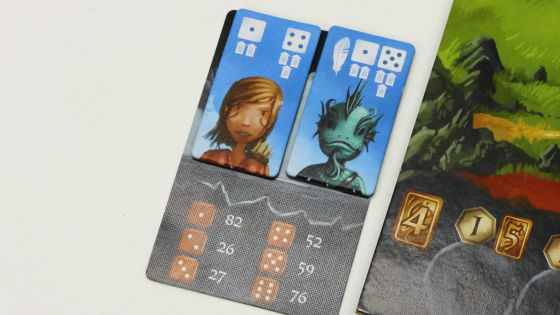
With the skill that you can re-dice the house card that I had built previously ... ...
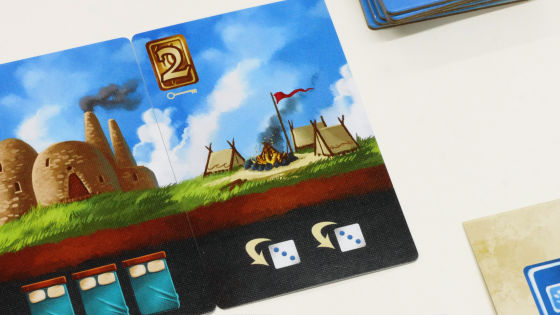
Get one mushroom token.
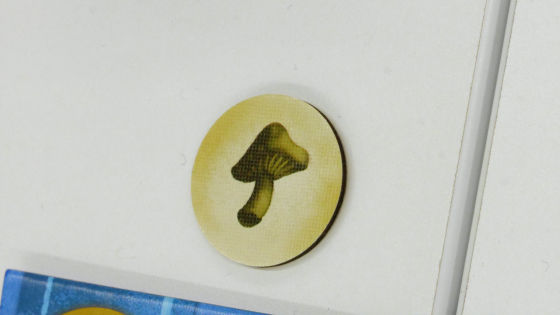
Evaluation also became plus 2.

This is the end of the 1st round as player 2 no longer has villagers who can take action.
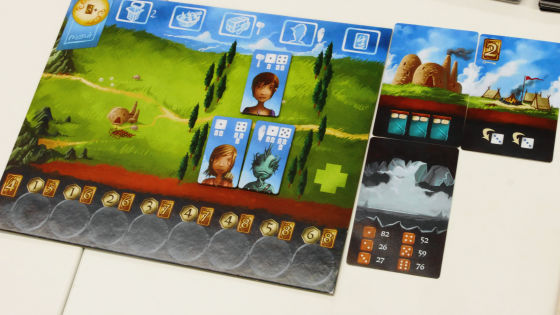
At the end of the round, we revive villagers from players who are playing first.
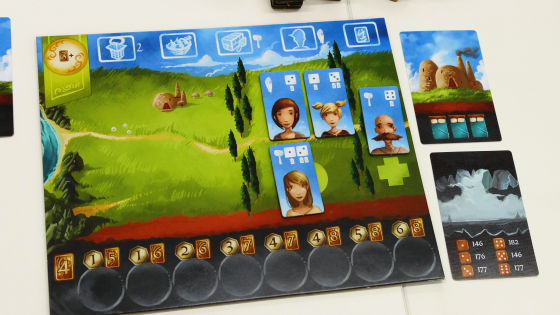
It is possible to revive villagers as many as the number of beds under the starting house card. Because it has three beds ......
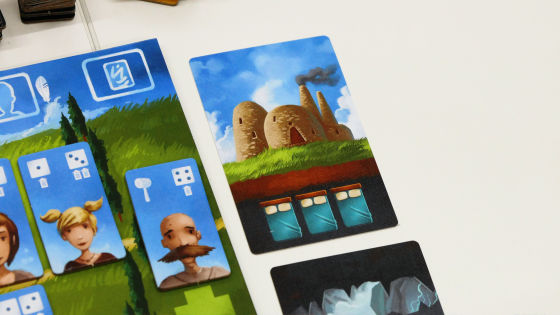
Three villagers resurrected from the rest zone.
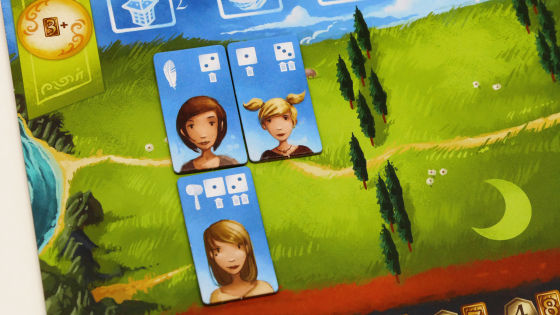
Bearded villagers are in the injured zone and the abandoned resurgence this time because there are not enough beds.
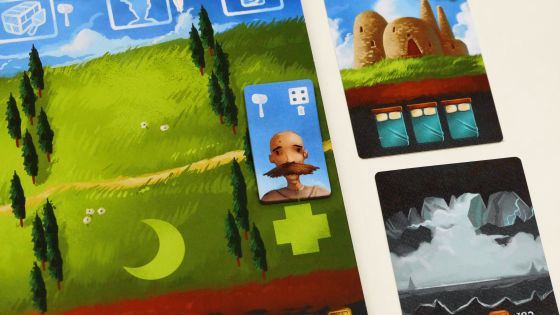
If you have cider tokens and potion tokens, you can also revive them with these. Both tokens can raise one zone with one, so if you have two, you can jump over the rest zone from the injured Zone in a stroke and revive it.
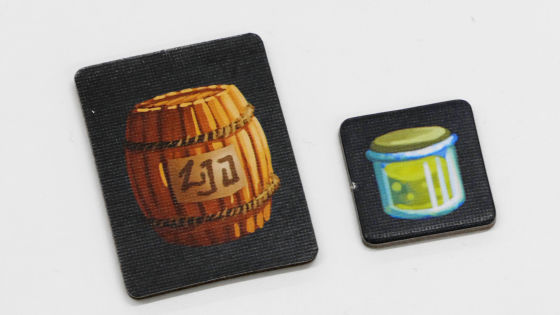
In addition, we receive coins by the number of "4" in the lower left corner of the player board.

The circle mass at the bottom of the player board is worrisome here.
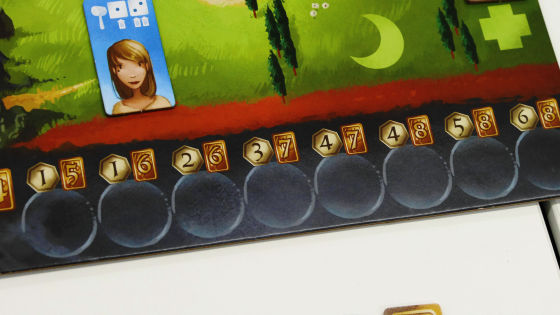
You can set up the item tokens you got here, and you can earn points at the end of the game by the number of the upper part and a coin at the end of the round. For example, if there is one mushroom token on the left, you can get 1 point at the end of the game and 5 coins at the end of the round.
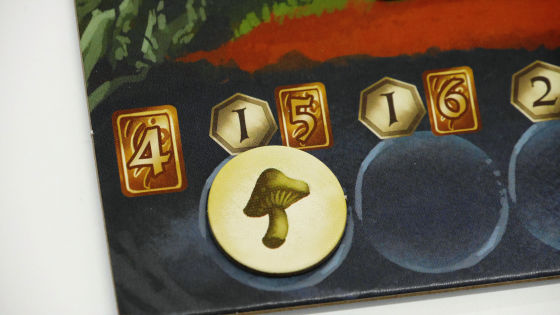
The more points you can earn and the more points you can earn, the more points you can earn, but the number of coins will increase, but you can not place items on the fifth from the beginning, you must order different items in order from the left. Also, tokens of the same kind can be arranged in an overlapping manner, and the points that can be obtained at the end of the game by the number of sheets are doubled and tripled.
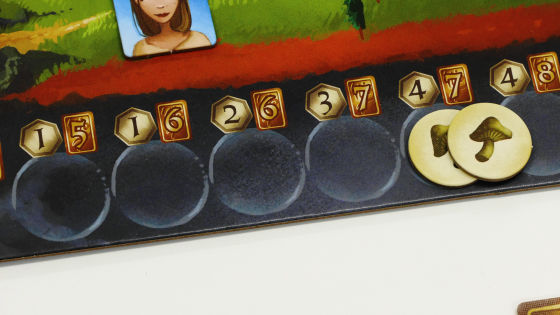
Even if you set up two in the first square and one in the next square like the image below, the points and the coins are only the number corresponding to the rope you put on the rightmost one. In this case, it will be one point and six coins.

The number of item tokens is limited, and the number of sheets is decreasing as you go below the tokens that are vertically arranged in the image. In other words, if it is the top mushroom and emerald, the probability of getting more than one will differ considerably. Considering this number of items you need to consider the type of item token to place.
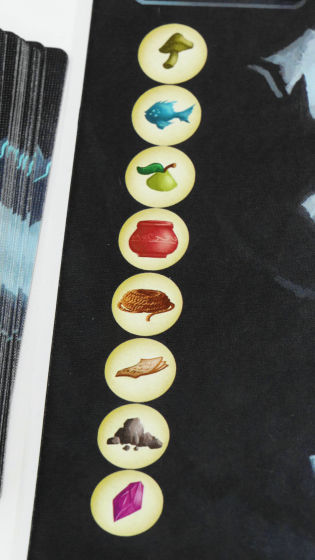
There are times when you get a house card with item tokens listed during play ... ....
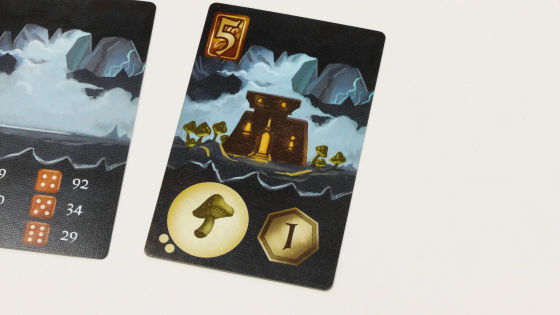
It is possible to leave a picture drawn by the number of white ○ ○ at the bottom left of the card from the mountain here.

You can get one token for each village person by "harvest" action item token placed. If you increase the same kind of tokens, the points and tokens you can earn at the end of the game and the round have changed, so harvesting is also an important action.

In addition, "labor" is an action that one villagers can use one coin to obtain one. It is rare to do labor during play, only when coins are absolutely insufficient.
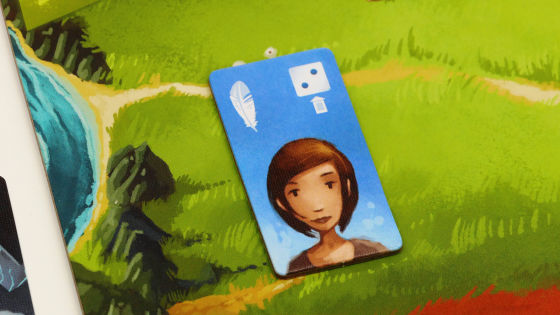
About seven rounds are over in about two hours.
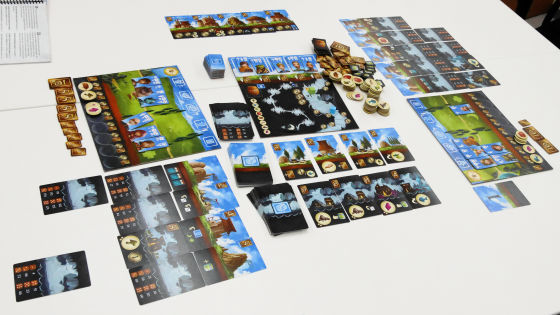
When all the rounds are over, it is calculation of points.
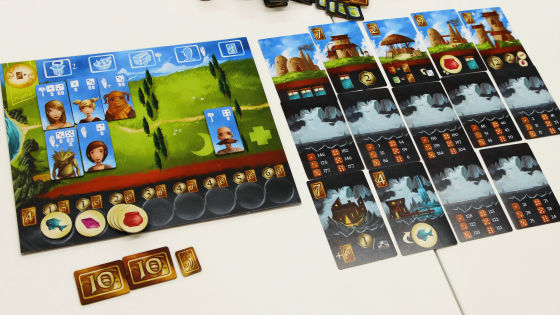
Player 1 possesses 25 coins, but you can not exchange coins for points.

In addition to collecting item tokens considerably, there are 4 points in the place of the key point "2 points", so we gained 8 points with 2 points × 4.
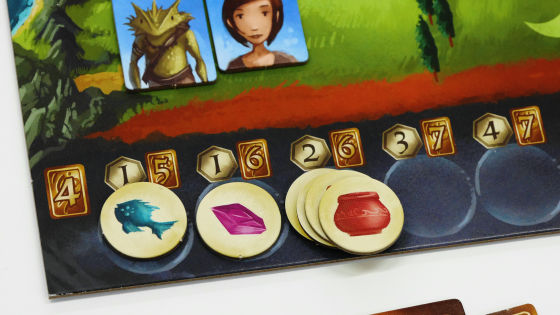
Also, I can earn points by the number of cards I built, so I add 6 points.
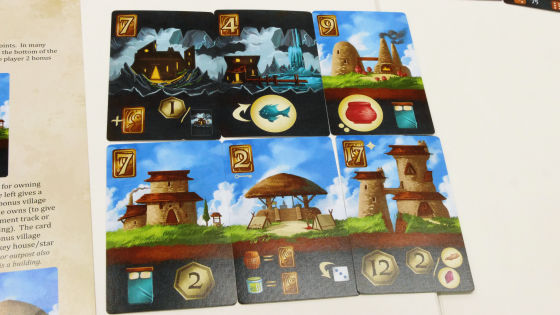
The following house cards that I had possessed the "point 2" skill, which will also add 2 points.
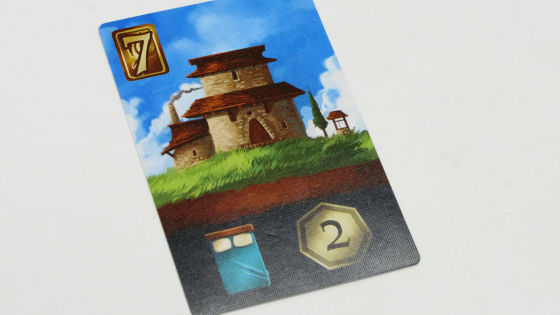
In addition, the star house card which got consumed 17 coins gets 2 points for each "paper" and "emerald" in addition to "12 points". Because I had two emeralds, 4 points were added and the total was 32 points.
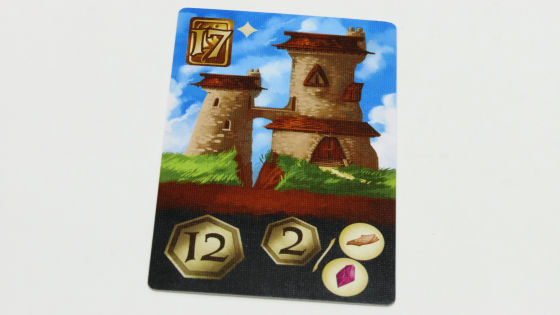
Next point settlement of player 2. Whether it will exceed 32 points will be the key to the game.
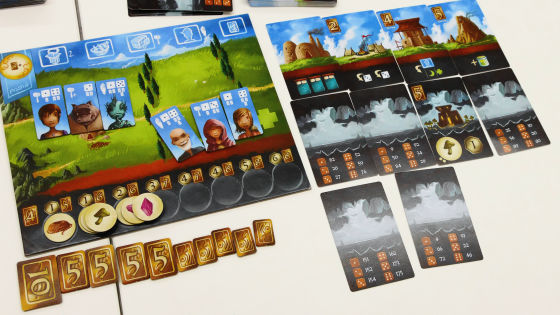
Player 2 collects item tokens, but a lot of coins are left over that can not be exchanged for points.
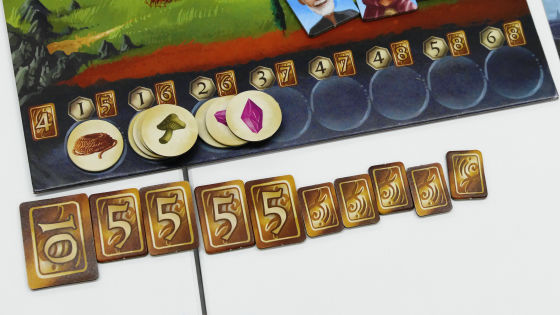
The number of house cards built was also as small as 4 sheets.
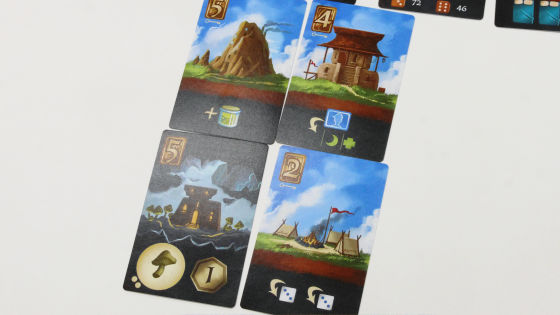
Also, only one point can be earned from the house card skills.

However, because the "evaluation" of the reputation board was higher than the player 1, 3 points were awarded as a reward, and the total was 16 points. The game closed with the victory of Player 1.
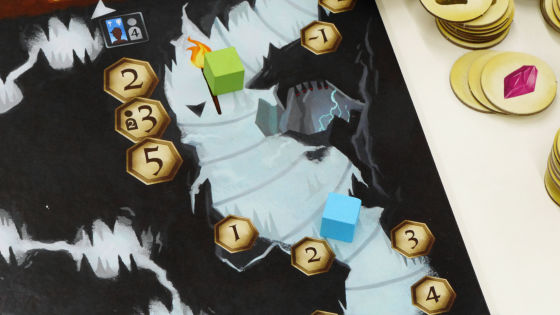
The special villagers have never appeared in this play, but they seem to be available at the action of "exploration".

Above and Below rules are complicated, but understanding everything makes it possible to play while thinking about the current situation and the previous things, and those who like to carefully plan a strategy seem to enjoy it considerably. However, as it is currently not possible to obtain the person who contributed with Kickstarter,Official siteWait for it to be sold in Japan or wait for Japanese version to be released in Japan.
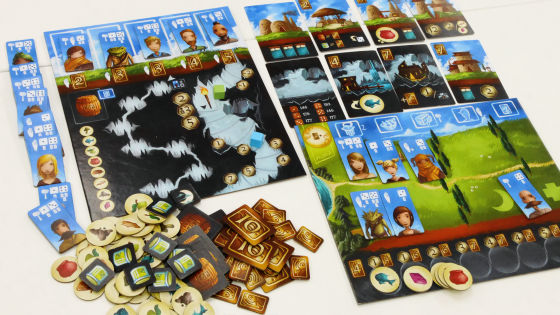
Related Posts:



